|
|
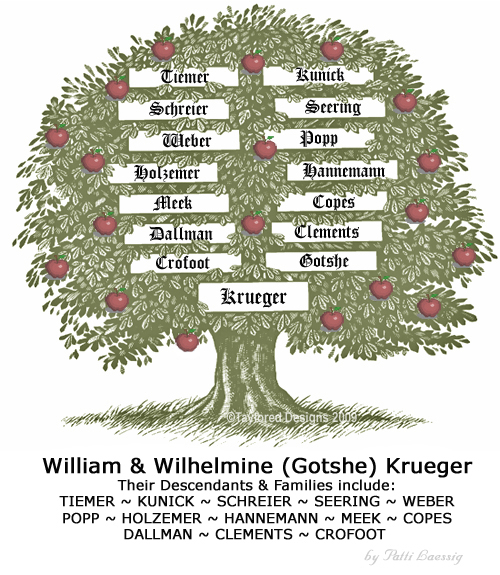 |
|
Patti has
sent in her genealogy with some great old photos of the Krueger-Gotshe
families from the Bonduel area as well as her families
from the western portion of Shawano County. Her
"detective work" regarding the Mattoon Mercantile mystery
put a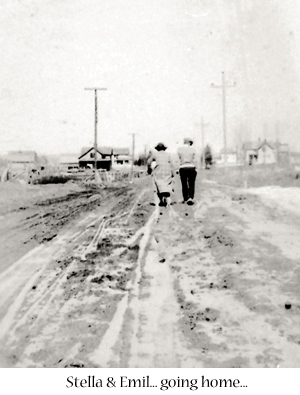 smile on my face -- today, we carefully look at cars and
license plates in the background of photos... Patti put
the pieces together comparing horse and carriage... and
when you see the photos, it clearly is the same horse &
carriage! And I'm sure Patti's cousin Stella is
pleased with the beautiful tribute to her... she sounds
like a memorable lady!
smile on my face -- today, we carefully look at cars and
license plates in the background of photos... Patti put
the pieces together comparing horse and carriage... and
when you see the photos, it clearly is the same horse &
carriage! And I'm sure Patti's cousin Stella is
pleased with the beautiful tribute to her... she sounds
like a memorable lady!
Patti's families immigrated
from Germany to Washington County, WI and then later moved
on to Hartland Twp., Shawano County, WI... with some
families later moving to Marathon and Lincoln counties.
In one of Patti's emails, she mentioned which of her
photos was one of her favorite: "The photo of Stella & Emil
walking down highway 97 towards home, is one of my
all-time favorite photos!!! That house on the left side
in that photo is where I grew up. My grandparents built
the house, then my parents bought it, and that was my
childhood home." So, I've made that the first photo
(adjacent) on the page -- it's my favorite of the
collection, too, as it seems to tells its own story.
It almost allows you to step back in time and you can
almost feel like you are walking behind them... as they
make their way home... talking about the news from town...
and the work to be done the following day at home...
enjoying each others companionship... very nice picture
indeed!
And Patti welcomes
additional information and would love to hear from any
researchers regarding her families... again, Patti, nicely
done! Here's a link to Patti's own webpage "Patti's
Ponderings and Putterings" - neat title! Families
include Krueger, Gotshe, Tiemer, Kunick, Schreier, Seering,
Weber, Popp, Holzemer, Hannemann, Meek, Copes, Dallman,
Clements and Crofoot |
| |
|
 |
|
 |
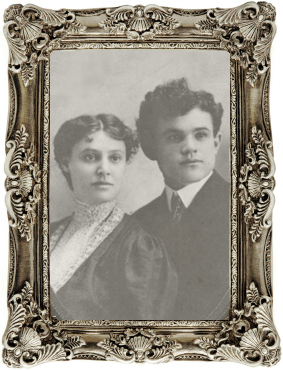 |
|
Wm.
& Anna (Krueger) Seering
Married April 23, 1902 in Shawano Co.
(Sister of
Clara Krueger Weber
Aunt of Stella Weber Popp) |
Mr. & Mrs. Louis Krueger
(Brother
of Clara Krueger Weber
Uncle of Stella Weber Popp) |
|
|
|
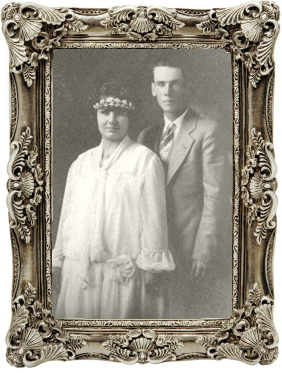 |
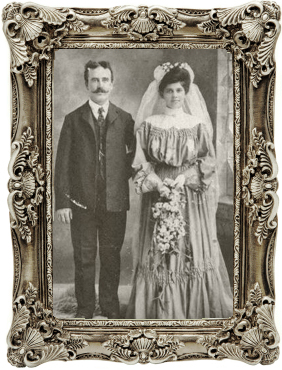 |
|
Emil & Stella (Weber) Popp |
Pete & Clara (Krueger) Weber
Married June 14, 1903 |
|
|
|
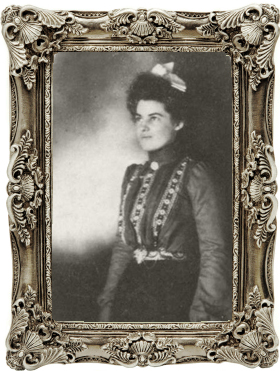 |
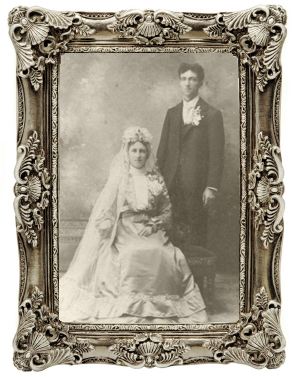 |
|
Mary Seering
(Stella Weber Popp's aunt) |
Mr.
& Mrs. Albert
Lutzke
Bonduel, Wisconsin |
|
|
|
|
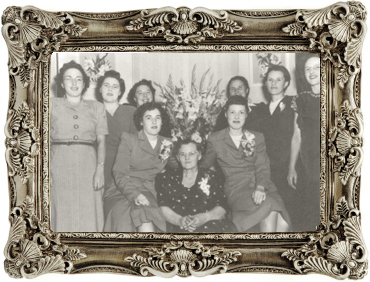 |
|
Anna
Seering and family from Bonduel, Wisconsin |
|
|
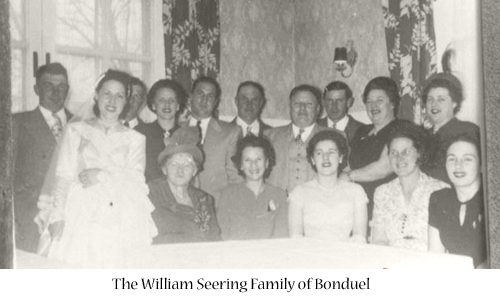 |
| |
|
 |
|
|
The Mattoon
Mercantile Mystery
~SOLVED!!!~
By Patti Laessig February 14, 2009
It was
1982 when I was accompanied by a friend with a 35mm camera
and a tri-pod to the home of my two bachelor uncles who
had a trunk full of family photographs preserved by my
grandmother, Mary Weber Laessig. She was the daughter of
Webertown's founders, Christian and Anna (Kaiser) Weber,
and the second wife of my grandfather, Frank (Francis
Hubert) Laessig. The Michael and Elisabeth (Kaiser) Weber
family immigrated from Freudenburg, a small village near Trier
in Germany in 1865 relocating to Centerville in Manitowoc
County. Michael and Elisabeth Weber's family consisted of
nine children: Magdalena born 22 May 1842, Christian born
12 Oct 1845, Michael born 30 Apr 1848, Elisabetha born 17
Mar 1851, Johann born 24 Oct 1854, Angela born 04 Nov
1855, Henry born in 1860, Franz born 08 May 1864, and
Peter born in 1867. To my knowledge, Magdalena,
Christian, Michael, Henry, and Peter lived to adulthood.
Also
immigrating to Wisconsin
were some of the Kaisers. Andreas Kaiser came to America
arriving in 1856, having also left Freudenburg, Germany on
June 24, 1856.
Andreas
first went to Ashford and established a farm there, where
his son Nicholas remained to carry on the operation of the
farm. There are records showing Andreas may have gone to
Manitowoc County for a time, as his brother Jacob located
there along with other relatives. Eventually he came to
Marathon County in order to buy affordable land so his
remaining sons could have farms and establish themselves
in that area of Wisconsin.
According to the Kaiser family, Andreas Kaiser came to
America with his three brothers and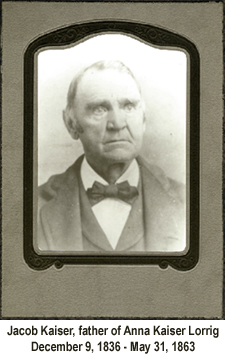 one sister. I have found information to confirm and locate
three brothers, but there is evidence a brother
Christianus also came with them but no information on him
has been found.
Andreas' brother John went to live in Cadott, Chippewa
County, Wisconsin. John was born in 1830 and died in
1908. He married Appolonia Esslinger. Nicholas Kaiser
born 11 Sep 1824, married Margaretha Esslinger, and
Andreas Kaiser born 18 Jan 1815 married Magdalena
Esslinger. The Kaisers brothers married the Esslinger
sisters, daughters of Mathias Eselinger[sic] and Catharina
Zehren. Their sister, Anna Esslinger born in 1814 married
Nicholas Weber. One son, Peter Esslinger, born 13 May
1826, married Anna Esser and made their home in Stanley,
Chippewa Co., Wisconsin.
one sister. I have found information to confirm and locate
three brothers, but there is evidence a brother
Christianus also came with them but no information on him
has been found.
Andreas' brother John went to live in Cadott, Chippewa
County, Wisconsin. John was born in 1830 and died in
1908. He married Appolonia Esslinger. Nicholas Kaiser
born 11 Sep 1824, married Margaretha Esslinger, and
Andreas Kaiser born 18 Jan 1815 married Magdalena
Esslinger. The Kaisers brothers married the Esslinger
sisters, daughters of Mathias Eselinger[sic] and Catharina
Zehren. Their sister, Anna Esslinger born in 1814 married
Nicholas Weber. One son, Peter Esslinger, born 13 May
1826, married Anna Esser and made their home in Stanley,
Chippewa Co., Wisconsin.
Jacob
Kaiser, half brother of Andreas went to Athens, Marathon
County, Wisconsin according to family... however he was
found to have been in Manitowoc County and his descendants
were found living in the Milwaukee, Wisconsin
area. Jacob, son of Nicholaus Kaiser and Margaretha Kaiser
(nee Kaiser) married Magdalena Weber, 21 May 1863 at
Centerville, Manitowoc County, Wisconsin. She was the
eldest daughter of the Michael and Elisabeth (Kaiser)
Weber mentioned earlier.
I
didn't know any of this information when we began laying
the photographs one by one on the floor, getting them in
focus under the camera on the tri-pod and creating a snap
shot of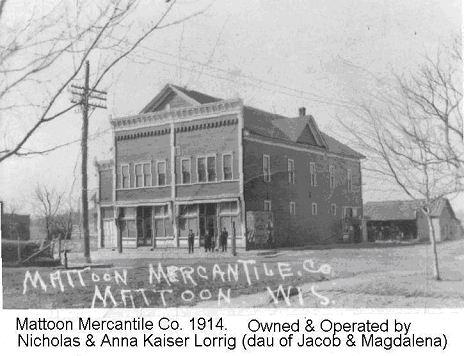 each one. What a treasure I had in that gift from my
uncles, allowing us to copy those pictures.
each one. What a treasure I had in that gift from my
uncles, allowing us to copy those pictures.
One
photo in particular was an enigma. That of a grand old
building labeled "The Mattoon Mercantile." No one could
tell me the significance of it. From time to time I would
come across the photo in my album and read with curiosity
the note written on the back, "At one time owned by
Christian Weber's sister, married to Mr. Kaiser." I made
a few futile attempts to contact people in regard to the
photo, but for years there was no information to be
found.
Eventually with the advent of computers, I put queries
around looking for information and still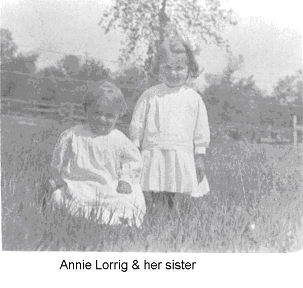 no further data could be found. Then a shirt-tail cousin
sent me a copy of Peter Weber's Last Will & Testament,
containing a list of heirs he left his property to. The
cousin had figured out where most of the descendants of
the Weber/Kaiser clan fit, but there were some names
neither he nor I recognized.
no further data could be found. Then a shirt-tail cousin
sent me a copy of Peter Weber's Last Will & Testament,
containing a list of heirs he left his property to. The
cousin had figured out where most of the descendants of
the Weber/Kaiser clan fit, but there were some names
neither he nor I recognized.
In the
trunk I found a photo of two little girls, with the name
"Annie Lorrig" on it.
It took
us three trips to the uncles to copy all the photos in the
trunk, and each time we visited we chatted about the
various photos, speculating on who they all were. It
would take many years to identify them, and only a very
few remain without names.
In a
final attempt to solve the mystery of the Mattoon
Mercantile photo, I posted queries listing the names
Kaiser, Weber, and Lorrig. This was the right combination,
and responses began to come and answers to long asked
questions began to emerge, thanks to fellow researchers
kind enough to assist.
One
clue lead to a website that was created by Robert Lorrig.
http://freepages.genealogy.rootsweb.ancestry.com/~antigowis/mattoon/lorrig.html
On his
website I found a photo of Francis Lorrig (Robert Lorrig
photo), same horse & buggy,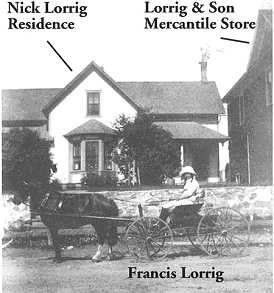 same retaining wall as my photo of Mrs. Tuc Lorrig.
same retaining wall as my photo of Mrs. Tuc Lorrig.
I was
very excited when I saw this photo, as I recognized the
horse and buggy and the retaining wall in front of the
house. I had copied a post card sent to my great
grandfather from "Mrs. Tuc Lorrig" with a lady in a
horse-drawn carriage in front of a retaining wall. The
photo I had copied was of a different woman in the same
carriage. Mrs. Tuc Lorrig.
Eventually I learned that Nicholas Lorrig was the
owner-operator of the Mercantile, and his wife's name was
Anna Kaiser. Shortly thereafter, a kind soul looked up
the death certificates of the couple and there it listed
Anna Kaiser's parents, Jacob Kaiser and Magdalena Weber.
Immediately I knew where Anna Kaiser fit into the family
and that she was not only my great aunt, but doubly so
because her father, Jacob, and my great great grandfather,
Andreas, were half brothers, and her mother, Magdalena
Weber, and my great grandfather, Christian Weber, were
brother and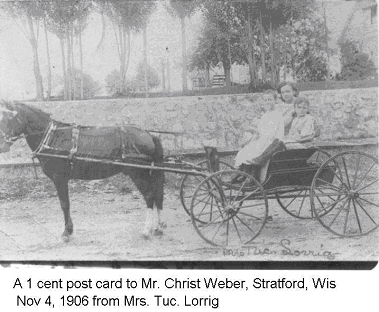 sister. Thus proving the notation on the photo…"Sister to
Christian Weber married a Mr. Kaiser" … and it was their
daughter Anna and her husband Nicholas Lorrig who operated
the Mattoon Mercantile.
sister. Thus proving the notation on the photo…"Sister to
Christian Weber married a Mr. Kaiser" … and it was their
daughter Anna and her husband Nicholas Lorrig who operated
the Mattoon Mercantile.
Soon
more information was found posted by Robert J. Lorrig at
Ancestry.com and from that I was able to fill in a lot of
the missing information, as well as confirm what I already
knew to be true. Plus I was able to make contact with
Robert and exchange information with him, and solve his
mystery as to the ancestry of his grandmother, Anna Kaiser
Lorrig.
It was
through the efforts of many people, including myself, that
all the pieces of this puzzle finally came together. It
really pays to never give up.
For
more information on these families contact Patti Laessig
at anaquea@dwave.net or
pattilaessig@yahoo.com
|
|
 |
|
|
by Patti Laessig February 14, 2009
One of the most colorful people I remember
from my childhood, was my dad's first cousin, Stella Weber
Popp. "Stell" to everyone who knew her. Stell was a
loving and friendly woman, having left her hometown of
"Webertown" after her marriage to Emil Popp, relocating
north to Tomahawk in Lincoln County, Wisconsin where they
raised their family.
Stell had an outgoing personality, and when
she entered the room her presence would be felt. She
commanded attention and with her genuine interest in her
loved ones, she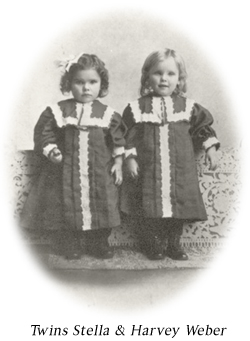 was a welcome visitor.
was a welcome visitor.
On a rare occasion we would get a visit
from Stell, and I would sit quietly listening to the
adults talk and joke around.
On a still more rare occasion, we would
take a long drive to Tomahawk and visit with Stell in her
little log cabin house out on highway 8. I marveled at
the huge logs that made up the little house.
Stella grew up at Webertown with her
parents Peter W. Weber and Clara Amelia Krueger Weber.
She was born January 26, 1905 in Eau
Pleine Township
[Webertown], along with her twin brother, Harvey. There
were many other siblings too.
There are delightful photos of these young
twins, dressed alike as much as brother and sister can be
dressed alike, and in those days they dressed quite
similarly. The one with bow in her hair is Stella.
As youngsters, Stella and Harvey proudly
show their contribution to the family dining table.
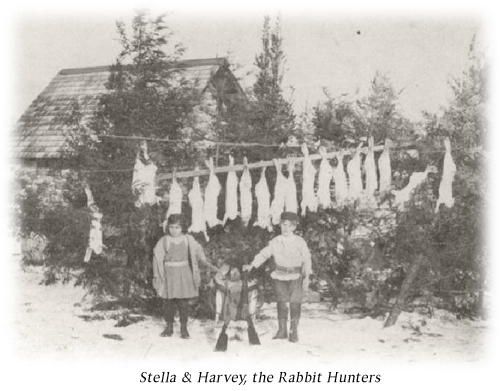
Still later in her young life, Stella was a
helper to her dad in his Saloon, the Pete Weber Saloon.
There is a semi-well known photo that appeared in a
newspaper some years ago as unidentified, which was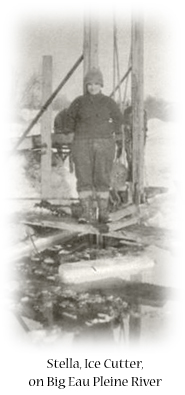 that of Stella bartending in her father's tavern. One
such photo hangs in the student center at the University
of
Wisconsin at
Stevens Point, Wisconsin.
that of Stella bartending in her father's tavern. One
such photo hangs in the student center at the University
of
Wisconsin at
Stevens Point, Wisconsin.
After the death of her father, Stella's
mother, Clara Krueger Weber took over the operation of the
tavern. It was a tedious task, but necessary to support
herself and her children.
"Aunt Clary" as she was known to my dad and
his generation, worked long and hard to support her
family. My dad would tell stories about the various
encounters she experienced, with not-so-nice vagrant-type
men who would distract her while someone stole the pot of
stew from the stove… there's even a newspaper write-up
about those scoundrels.
Though Aunt Clary was gone long before I
began gathering her family history, and I don't remember
ever meeting her, her legacy lives on in her descendants,
and the memories of a long-gone pioneer town named after
Clara's husband's father, Christian Weber, who settled
just south of the Big Eau Pleine River and built his
little town along with his family and friends. In that
little town was a Catholic church named Holy Trinity,
founded by Mr. Weber and others, and a Lutheran church, a
general store founded and operated by Mike Wagner, and
various other businesses that provided the needed services
of the people of that era. Peter W. Weber, Clara's
husband took over the proprietorship of the Saloon, but
also was the local ice cutter, providing ice to the
settlement. There are photos of Stella as a young girl
out on the ice with the ice cutting equipment. There was
also lumberjacking, providing logs to the Weber sawmill,
and others in the vicinity, as well as lumber to build
their homes and out buildings.
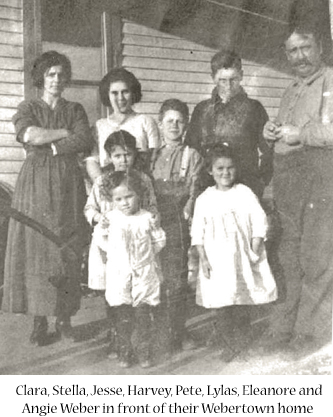
Early, untimely deaths were not uncommon in
those days. Two of Clara and Peter's children, Delores and
Lester died on March 28, 1912 of what was called black
diphtheria. There were Jenny, Johnny, Loretta, Jesse,
Lylas, Angie, Lester Lloyd, June who died at birth in
1919, Melvin and Elinore, known as "Girlie". To my
knowledge, Stella, Harvey, Jesse, Lylas, Angie, Lester
Lloyd, Melvin and Elinore grew to adulthood. 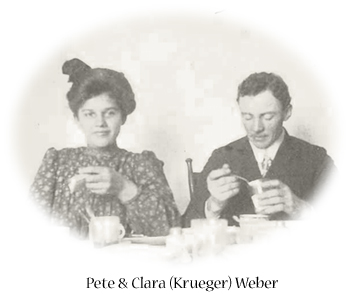
There was a lot of hard work to be done to
sustain a family in those days, as all goods had to be
either hand made or purchased on the meager earnings of
these early settlers of the area. There was seasonal work
that had to be done, such as ice cutting at the river,
hauling it to the area people, wood cutting for fuel,
lumbering for sale to the lumber companies and local
mills. Farming was becoming a way of life for many of the
area people once the land was cleared.
Most saloons served meals so one could stop
for refreshment and at the same time enjoy sustenance. In
those days, ladies did not go into the barrooms. There
were rooms off to one side where they would gather and
visit while the men shared their stories and company at
the bar, often lined with spittoons for their well chewed
tobacco. It was a gross task to clean them, Stella told
me. She managed to get stuck with that nasty clean-up
job.
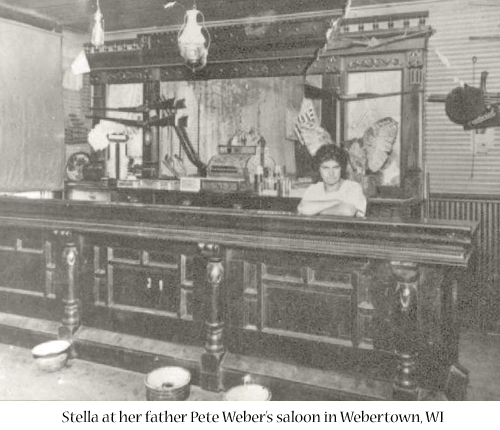
On June 23, 1926 Stella Weber and Emil Popp
were married. They raised a family of five sons.
I was fortunate to have had the opportunity
to visit with Stella in her later years and listen to her
reminisce about the days of her childhood and young
adulthood. Many of her fond memories were shared with me
so that I could record them for posterity. She also had a
collection of photos she allowed me to copy, some
one-of-a-kind heirlooms, such as the one of her standing
on the ice cutting rig.
The old saloon building is long gone, as
are the early settlers of that bye-gone era. Many of the
people living there today have little recollection of the
settlement that flourished along the Big
Eau Pleine River in Eau Pleine Township in
Marathon
County, Wisconsin. What is left are faded photos in old
obscure albums and a few notes jotted here and there to
bring back the memories of those who lived and prospered
here, and who have long since gone on their way.
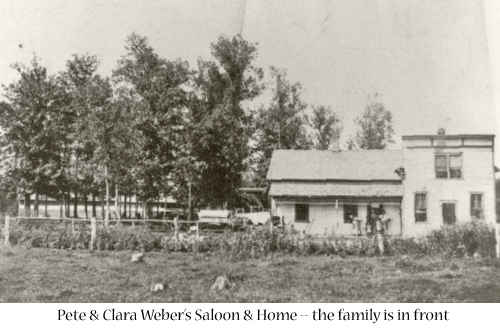
For
further information on the Peter W. Weber ~ Clara A.
Krueger family, contact Patti Laessig at anaquea@dwave.net
or
pattilaessig@yahoo.com.
|
|
 |
|
|
Descendants of William Krueger
(For a very
COMPLETE PDF FILE with notes, click here...)
Descendants of
Christianus Kaiser
(PDF
FILE) |
|
 |
|
Chicago:
J.H. Beers & Co. 1895
Commemorative Biographical Record of the Upper Wisconsin
Counties of Waupaca, Portage, Wood, Marathon, Lincoln,
Oneida, Vilas, Langlade and Shawano, containing biological
sketches of Prominent and Representative Citizens, and
many of the early settled families. Pgs 936 - 37
WILLIAM SEERING is a self-made man, who has worked his way
upward to a position of affluence unaided save by his own
perseverance, diligence and good management. The record of
such a man should serve as a source of encouragement to
others, and it is with pleasure that we present the sketch
of his life to our readers
Mr. Seering was born in Prussia, November 18, 1839, son of
Gotfried Seering, farmer and miller, who in later life
engaged in hotel keeping. Gotfried Seering was married in
his native land to Miss Sophia Hoffman, and ere leaving
Germany they became the parents of three sons and two
daughters. The father was at one time possessed of a
comfortable competence, but during the revolution of 1848
his property was all swept away, and he then concluded to
come to the United States. In the spring of 1850 he
embarked with his family at Hamburg on the "North
America," which reached New York after a voyage of
thirty-three days, a remarkably short voyage for that
period. He made his way to Milwaukee, Wis., leaving his
family there for a short time while he went to Mayville,
Dodge county, to find a relative. Thither he took his
family in a wagon, and for about a year was employed in a
distillery in Mayville, after which he purchased forty
acres of new land, building thereon a log cabin. He then
began the cultivation of his farm, and as his financial
resources increased extended its boundaries by additional
purchase. The children of the family were: William;
August, a farmer of Hartland township, Shawano county;
Julius, a farmer of Dodge county, Wis.; Louisa, wife of
August Waner, of Dodge county; one daughter who died in
Milwaukee soon after the arrival of the family in this
country; Amelia, wife of William Swan, of Dodge county;
and Carl, who died at the age of fourteen years. The
father spent the last seven years of his life at the home
of his daughter, Mrs. Swan, his wife passing away five
years before him. Both were members of the Lutheran
Church, and were laid to rest in Woodland Cemetery. The
father had prospered in his undertakings, and by
persistent labor had acquired a good farm.
The schoolhouse where William Seering pursued his studies
was far distant from his home, and, as his services were
needed on the farm, his educational privileges were, in
consequence, limited, but he has always been a warm friend
of education, and as a school director has done effective
service in its interest. He early became familiar with the
hardships and experiences of frontier life, and with the
arduous task of developing a new farm, giving the benefit
of his services to his father most of the time until his
marriage. At the age of twenty-two, in Williamstown, Dodge
county, Mr. Seering wedded Caroline Uhlerich. His father
then gave him a wagon and yoke of oxen, and in 1861 he
came to Shawano county, where the year before he had
purchased a tract of government land in Section 15,
Hartland township. The household goods were moved in a
wagon drawn by oxen, and they were ten days on the road,
being obliged to cut their way through the woods in order
to reach their farm. He built a log house, 20 x 24 feet,
and here began life in true pioneer style. A year and a
half later his wife died, and, as his own health was poor,
he returned to his parents' home in Dodge county,
remaining with them until his second marriage. On July 3,
1867, in Mayville, Wis., he wedded Miss Johanna Petermann,
who was born in Germany June 3, 1848, a daughter of
Christian Petermann, a farmer, with whom she came to this
country at the age of eighteen years. Again Mr. Seering
made the trip with a wagon and ox-team to his farm in
Hartland township, and has since made his home thereon. He
now has 160 acres of rich land, of which 130 acres are
under a high state of cultivationin fact, his farm is the
best in Hartland township, it being assessed higher than
any other. The buildings upon the place stand as monuments
to his thrift and enterprise, and are modern in structure,
and models of convenience. His fine brick residence was
erected in 1880, and the other improvements are in keeping
with the home.
The children of Mr. and Mrs. Seering are Albert, a
merchant of Bonduel; Frank, who clerks in his father's
store; Emma, wife of Herman Siebert; and Robert, Charley,
Helen and Elizabeth, at home. Mr. Seering has always been
a Democrat, and has served altogether for fifteen years as
supervisor, and for nine years as school treasurer. In
August, 1892, in company with Frank Siebert, he purchased
the mercantile business of Philip Meyer, of Bonduel, of
which he is now the sole proprietor. He possesses
excellent business ability, and his enterprise and
well-directed efforts have brought to him a high degree of
prosperity, which he well merits. He and his wife are
members of the Lutheran Church. |
|
|
 |
|
|
|